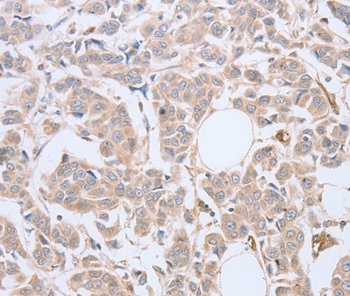

| WB | 咨询技术 | Human,Mouse,Rat |
| IF | 咨询技术 | Human,Mouse,Rat |
| IHC | 1/15-1/50 | Human,Mouse,Rat |
| ICC | 技术咨询 | Human,Mouse,Rat |
| FCM | 咨询技术 | Human,Mouse,Rat |
| Elisa | 咨询技术 | Human,Mouse,Rat |
| Aliases | CDS; CGI58; IECN2; NCIE2 |
| Entrez GeneID | 51099; |
| WB Predicted band size | 39kDa |
| Host/Isotype | Rabbit IgG |
| Antibody Type | Primary antibody |
| Storage | Store at 4°C short term. Aliquot and store at -20°C long term. Avoid freeze/thaw cycles. |
| Species Reactivity | Human |
| Immunogen | Fusion protein corresponding to residues near the C terminal of human Abhydrolase domain containing 5 |
| Formulation | Purified antibody in PBS with 0.05% sodium azide. |
+ +
以下是关于ABHD5抗体的3篇参考文献及其摘要概括:
---
1. **文献名称**:*Mutations in CGI-58. the gene encoding a new protein of the esterase/lipase/thioesterase subfamily, in Chanarin-Dorfman syndrome*
**作者**:Lefèvre, C. et al.
**摘要**:该研究首次将Chanarin-Dorfman综合征(一种脂质代谢疾病)与ABHD5(CGI-58)基因突变相关联,并揭示了ABHD5在调节脂滴代谢中的关键作用。研究通过抗体检测发现患者中ABHD5蛋白功能异常,导致脂质过度积累。
---
2. **文献名称**:*Adipose triglyceride lipase-mediated lipolysis of cellular fat stores is activated by CGI-58 and defective in Chanarin-Dorfman Syndrome*
**作者**:Lass, A. et al.
**摘要**:本文阐明了ABHD5(CGI-58)通过激活脂肪甘油三酯脂肪酶(ATGL)促进脂解的作用机制。研究使用ABHD5抗体进行蛋白质相互作用实验,证明ABHD5缺失会导致脂解障碍,从而加剧脂滴堆积。
---
3. **文献名称**:*ABHD5 regulates lipid droplet dynamics and interacts with perilipin 1 in live cells*
**作者**:Ghosh, A. K. et al.
**摘要**:该研究利用ABHD5特异性抗体结合免疫荧光技术,揭示了ABHD5与脂滴表面蛋白perilipin 1的动态互作,表明其在调控脂滴形态和脂质动员中的空间特异性功能。
---
如需更详细文献信息,可进一步限定研究领域(如疾病模型、实验方法等)。
ABHD5 (α/β-hydrolase domain-containing protein 5), also known as CGI-58. is a lipid metabolism regulator encoded by the ABHD5 gene. It plays a critical role in lipolysis by activating adipose triglyceride lipase (ATGL), the rate-limiting enzyme for triglyceride hydrolysis. Structurally, ABHD5 contains a conserved α/β-hydrolase domain but lacks enzymatic activity, functioning instead as a coactivator. Mutations in ABHD5 are linked to Chanarin-Dorfman syndrome, a rare autosomal recessive disorder characterized by neutral lipid accumulation in tissues, highlighting its importance in lipid homeostasis. Dysregulation of ABHD5 is also implicated in metabolic disorders, including obesity, diabetes, and hepatic steatosis.
ABHD5 antibodies are essential tools for studying its expression, localization, and interactions. These antibodies, often generated against specific epitopes (e.g., N-terminal or C-terminal regions), enable detection via Western blotting, immunofluorescence, and immunohistochemistry. Researchers use them to explore ABHD5’s role in lipid droplet dynamics, autophagy, and cell signaling pathways. Monoclonal and polyclonal variants are available, with validation typically involving knockout controls or siRNA-mediated silencing. ABHD5 antibodies have advanced understanding of its dual roles in lipid metabolism and disease pathogenesis, offering potential insights into therapeutic strategies for metabolic syndromes. Their specificity and application across models (cells, tissues, or organisms) make them vital for mechanistic and translational research.
×